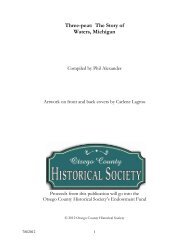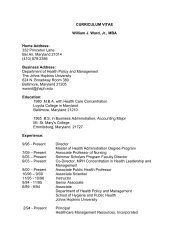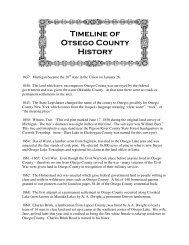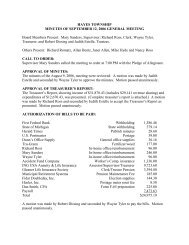The Polish in Otsego County - Otsego Community Connection
The Polish in Otsego County - Otsego Community Connection
The Polish in Otsego County - Otsego Community Connection
You also want an ePaper? Increase the reach of your titles
YUMPU automatically turns print PDFs into web optimized ePapers that Google loves.
<strong>The</strong> <strong>Polish</strong> <strong>in</strong> <strong>Otsego</strong> <strong>County</strong>Laura Walker1971<strong>The</strong> <strong>Polish</strong> were one of the prom<strong>in</strong>ent ethnic groups among the pioneer settlers <strong>in</strong> <strong>Otsego</strong><strong>County</strong>. <strong>The</strong> results of their <strong>in</strong>dustry and enterprise are much <strong>in</strong> evidence <strong>in</strong> the <strong>County</strong>today. Unhappily they left few records and mementos to ease the lot of historians whowould write of their presence and accomplishments.Due to the language barrier and the limited means of transportation and communicationof the early days, social activities were almost completely restricted to others of their owngroup. Another factor which made them reluctant to mix readily or to fraternize was theheritage of their former life <strong>in</strong> Poland. Whether they had lived under German or Russiandom<strong>in</strong>ation, they had experienced both rejection and exploitation by those who controlledtheir lands and production. Because they wished to determ<strong>in</strong>e their own dest<strong>in</strong>ies and notlive merely as puppets, many left their homeland. <strong>The</strong>se adventurers showed the courage,determ<strong>in</strong>ation and desire for freedom of the early <strong>in</strong>habitants of <strong>Otsego</strong> <strong>County</strong>.Settlers did not arrive <strong>in</strong> <strong>Otsego</strong> <strong>County</strong> until about 1868. <strong>The</strong> delay was due <strong>in</strong> part tothe reports of government surveyors who were <strong>in</strong> the area <strong>in</strong> 1840. <strong>The</strong>y surveyed a 25 or30 county region, but their reports gave the impression that this part of Michigan wasmostly marshland and unfit for cultivation.<strong>Otsego</strong> Lake Village was established <strong>in</strong> 1872, with the first railroad l<strong>in</strong>e reach<strong>in</strong>g thatpo<strong>in</strong>t <strong>in</strong> May of 1873. This l<strong>in</strong>e, the Jackson, Lans<strong>in</strong>g and Southern, was extended to thepresent site of Gaylord by July of that year. <strong>The</strong> first known <strong>Polish</strong> immigrant, MichaelSwantek, was employed <strong>in</strong> the construction of this l<strong>in</strong>e along <strong>Otsego</strong> Lake <strong>in</strong> 1873. (2)<strong>The</strong> follow<strong>in</strong>g year, 1874, saw the first <strong>Polish</strong> homestead established by Michael Merkeltwo miles east of Gaylord. (3)From that date until the early 1900s, <strong>Polish</strong> immigrants cont<strong>in</strong>ued to come to <strong>Otsego</strong><strong>County</strong>. <strong>The</strong> earlier arrivals were primarily families com<strong>in</strong>g directly from Poland.Around the turn of the century there were also <strong>Polish</strong> families who remigrated from theeastern United States. As the <strong>Polish</strong> families established themselves <strong>in</strong> their new homes,they wrote to relatives and friends back <strong>in</strong> Poland, encourag<strong>in</strong>g them to come also. Ofthose who moved here from the east, many were attracted by newspaper advertisementstell<strong>in</strong>g of cheap lands and opportunities to prosper <strong>in</strong> northern Michigan.Though Michigan was noted for its vast stands of white p<strong>in</strong>e, there were extensivehardwood forests <strong>in</strong> the <strong>Otsego</strong> <strong>County</strong> region as well. It was <strong>in</strong> these hardwood grovesthat the homesteads of many <strong>Polish</strong> settlers were located. After timber was cut for thehomes and outbuild<strong>in</strong>gs, that rema<strong>in</strong><strong>in</strong>g was cut and burned to make way for crop lands.This was a slow, laborious process and only a few acres could be cleared each year. It isironic that large quantities of hardwood, which were burned as a valueless nuisance tothese settlers, would have found a ready market <strong>in</strong> the charcoal and last block <strong>in</strong>dustriesthat came a few years later.1
Crops were raised primarily to provide sustenance for the family. Cows, chickens andpigs also provided food for the family. Any surplus produced was used to barter for stapleitems and sometimes sold for cash. Potatoes, vegetables and other perishables for w<strong>in</strong>tereat<strong>in</strong>g were stored <strong>in</strong> root cellars. Wild fruits and berries were harvested <strong>in</strong> season andpreserved. Lack of any type of cold storage restricted the butcher<strong>in</strong>g of pigs or cows tothe w<strong>in</strong>ter months. Eggs and butter were generally used as a medium of exchange, but onspecial occasions, such as Christmas and Easter, they were utilized <strong>in</strong> the home to givethe family a treat.<strong>The</strong> log cab<strong>in</strong> was the home for the early <strong>Polish</strong> families. It was small, usually with aroom for cook<strong>in</strong>g and eat<strong>in</strong>g and a bedroom for the parents and small children on theground floor. <strong>The</strong>re was also sometimes a liv<strong>in</strong>g-room. Any upstairs space served assleep<strong>in</strong>g quarters for the older children.<strong>The</strong> size of the house had little relationship to the size of the family, most of which werelarge. <strong>The</strong> family was a close knit unit, with all members shar<strong>in</strong>g <strong>in</strong> the responsibilities.<strong>The</strong> younger children had household tasks to do and the older ones helped with thefarm<strong>in</strong>g.Families not only worked together, but they shared times of recreation. Neighbors wouldmeet at a home, have d<strong>in</strong>ner, exchange experiences, and enjoy danc<strong>in</strong>g. <strong>The</strong>re wasusually a fiddler <strong>in</strong> the group to provide the music for danc<strong>in</strong>g or enterta<strong>in</strong>ment.Conveniences taken for granted today were unknown. If the mother did not make herown soap, she could obta<strong>in</strong> it from an it<strong>in</strong>erant peddler <strong>in</strong> exchange for wood ashes.Often the especially soiled clothes were soaked <strong>in</strong> lye-water obta<strong>in</strong>ed by bleach<strong>in</strong>g woodashes. Boil<strong>in</strong>g, scrubb<strong>in</strong>g on a washboard and r<strong>in</strong>s<strong>in</strong>g completed the laundry process. <strong>The</strong>water supply often depended on a ra<strong>in</strong> barrel or was hauled from a nearby lake. <strong>The</strong>earliest wells were dug and water raised with a bucket and rope.When <strong>in</strong>juries or illnesses occurred, mother had to be both doctor and nurse. <strong>The</strong> luckyone might have a family medical book as a guide. Home remedies were widely accepted.Seeds and roots were gathered for medic<strong>in</strong>al use. Catnip tea was used for stomachdisorders and pumpk<strong>in</strong> seeds for kidney diseases. Infection was treated with a l<strong>in</strong>seedpoultice. Colds were dosed with onion syrup or a few drops of kerosene on sugar. Amidwife was the only help available at the deliveries of babies.Life on the farm was less demand<strong>in</strong>g <strong>in</strong> the w<strong>in</strong>ter months so most of the men soughtemployment <strong>in</strong> the lumber camps. <strong>The</strong>se seasons <strong>in</strong> the woods were long and the workwas arduous. Depend<strong>in</strong>g on how far he lived from the lumber camp, the man might beaway from his family for many weeks at a time, possibly gett<strong>in</strong>g home only once or twicedur<strong>in</strong>g the entire w<strong>in</strong>ter. His pay would vary from $10.00 to $18.00 a month plus roomand board. Some came from as far away as Sag<strong>in</strong>aw to work <strong>in</strong> the Gaylord camps andsome men worked just for room and board. Nearly everyone walked from their homes tothe camp.2
Very little luggage was needed; usually a few extra clothes and possibly a pillow wouldsuffice. A straw-filled wooden bunk and horse blankets provided sleep<strong>in</strong>g quarters. <strong>The</strong>bunk rooms were equipped with wooden benches and kerosene lamps. Lights were out at9:00, as all hands were up at 4:00 AM for a hearty breakfast before go<strong>in</strong>g <strong>in</strong>to the woods.Food served <strong>in</strong> the camps was better and <strong>in</strong> greater quantity than the family had at home.One item not usually available was eggs. A cookie called the "square timber" was apopular item <strong>in</strong> most camps, as were molasses cookies. <strong>The</strong> men's <strong>in</strong>frequent visits homewere looked forward to by his children because the camp cook would send along a supplyof these as a treat.To help ease the burden of provid<strong>in</strong>g for the family, it was not unusual for boys as youngas fifteen to work <strong>in</strong> the lumber camps. Young girls were sometimes hired as cooks. At acamp on the Black River a thirteen year old girl did the cook<strong>in</strong>g for a crew of 18 men. (4)<strong>The</strong> p<strong>in</strong>e lumber<strong>in</strong>g had reached its peak and was nearly depleted by 1890. At about thistime the Detroit Iron and Furnace Company established a charcoal operation. Locatedabout two miles north of Gaylord, its twelve kilns utilized thousands of cords of mapleeach year. Its product was shipped to Detroit weekly by railroad. <strong>The</strong> charcoal kilns were<strong>in</strong> operation less than ten years, but the Dayton Last Block Works, which was establishedalso around~1890, cont<strong>in</strong>ued <strong>in</strong> operation until about 1930.(5) Both of these hardwoodbased <strong>in</strong>dustries provided extra <strong>in</strong>come employment for the farmers. Those who hadteams could hire out for haul<strong>in</strong>g.Many of the <strong>Polish</strong> housewives were able to help augment the family <strong>in</strong>come by customsew<strong>in</strong>g. Wedd<strong>in</strong>g dresses were an item the local seamstresses were often called on toproduce.<strong>The</strong> farmland <strong>in</strong> <strong>Otsego</strong> <strong>County</strong> was found to be well suited for rais<strong>in</strong>g potatoes. <strong>The</strong>yhad become the pr<strong>in</strong>ciple cash crop of the <strong>Polish</strong> farmers. <strong>The</strong> potato harvest gave theyoung boys an opportunity to earn extra money by pick<strong>in</strong>g up potatoes. <strong>The</strong> potato is stillthe lead<strong>in</strong>g farm product of <strong>Otsego</strong> <strong>County</strong> today, but the harvest<strong>in</strong>g process has beencompletely mechanized.<strong>The</strong> families who lived off the ma<strong>in</strong>ly traveled roads were often isolated for long periodsof time <strong>in</strong> the w<strong>in</strong>ter. <strong>The</strong> ma<strong>in</strong> roads were kept passable by us<strong>in</strong>g a snow-roller. <strong>The</strong>township operated either a wooden or steel roller, which was about six feet <strong>in</strong> diameterand ten feet wide. Three teams of horses would be needed to pull these. <strong>The</strong> snow-packedroads would be the last to break up dur<strong>in</strong>g the spr<strong>in</strong>g thaw.Rural mail service <strong>in</strong> <strong>Otsego</strong> <strong>County</strong> was <strong>in</strong>augurated April 15, 1904 (6). Before thatdate, mail was picked up at the Gaylord Post Office. <strong>The</strong> areas of greatest populationdensity were served by Del Shelter and Clarence Murner. (7) <strong>The</strong> routes were about 27miles each. A horse-drawn light sleigh was used <strong>in</strong> the w<strong>in</strong>ter and a wagon the rest of theyear. While the mail carrier parked <strong>in</strong> a drive to eat his lunch, a feed bag of oats wouldreplenish the horses' energy supply. Often <strong>in</strong> cold weather the carrier would be <strong>in</strong>vited<strong>in</strong>side to have a hot cup of coffee with his lunch.3
<strong>The</strong> <strong>Polish</strong> families who settled <strong>in</strong> the village of Gaylord experienced a different type ofliv<strong>in</strong>g than those on farms. <strong>The</strong> public water distribution system was available <strong>in</strong> theearly 1880s. <strong>The</strong> court house was built <strong>in</strong> 1891 and the first electricity arrived <strong>in</strong> 1897.<strong>The</strong> only bank <strong>in</strong> <strong>Otsego</strong> <strong>County</strong> was founded <strong>in</strong> Gaylord <strong>in</strong> 1893. (8) <strong>The</strong> mail had to bepicked up at the Gaylord Post Office until about 1954, when house delivery began. (9)Gaylord began pav<strong>in</strong>g its streets <strong>in</strong> 1921 and the sewer system was started <strong>in</strong> 1933. (10)Gaylord was first a trad<strong>in</strong>g center for farmers and later supplied lumber camps. Several<strong>Polish</strong> men established bus<strong>in</strong>esses upon arrival <strong>in</strong> Gaylord. Later on others took overbus<strong>in</strong>esses already established. When possible, the <strong>Polish</strong> consumers would patronize a<strong>Polish</strong> bus<strong>in</strong>essman. Available were grocers, dry good stores and a meat market.<strong>The</strong> service of a livery stable was available and the men could f<strong>in</strong>d relaxation <strong>in</strong> a <strong>Polish</strong>ownedsaloon.<strong>The</strong> hitch<strong>in</strong>g post was a familiar sight on Ma<strong>in</strong> Street prior to the automobile. Milk <strong>in</strong>cans was delivered by a horse drawn wagon, the housewife provid<strong>in</strong>g her own kettle, panor other conta<strong>in</strong>er.Typhoid fever was a common disease <strong>in</strong> the early 1900's. Many young adults lost theirlives to this dread malady. It was believed the method of milk delivery may havecontributed to the typhoid, as the epidemic appeared to subside when this method of milkdelivery was discont<strong>in</strong>ued.<strong>Polish</strong> was the language spoken <strong>in</strong> the homes. Because the husband's work took him <strong>in</strong>toassociations where English was spoken, it was necessary that he learn this secondlanguage. He would work at improv<strong>in</strong>g his ability to communicate <strong>in</strong> English byacquir<strong>in</strong>g a dictionary and study<strong>in</strong>g it <strong>in</strong> the even<strong>in</strong>gs by the light of kerosene lamps.When he had achieved sufficient mastery of the English, he would assist others seek<strong>in</strong>ghelp.<strong>The</strong> <strong>Polish</strong> children were impressed with their need of the English language when theyentered school. <strong>The</strong> teacher spoke only English, mak<strong>in</strong>g it imperative that the child wasteno time <strong>in</strong> master<strong>in</strong>g this second language. Because their contacts were more limited,many <strong>Polish</strong> housewives did not learn to speak English.<strong>The</strong> <strong>Polish</strong> custom was to make a gala occasion of their wedd<strong>in</strong>gs. Festivities began witha breakfast <strong>in</strong> the home of the bride follow<strong>in</strong>g the Nuptial Mass, and the joyouscelebration cont<strong>in</strong>ued throughout the day. In the even<strong>in</strong>g there was danc<strong>in</strong>g, often held <strong>in</strong>the barn, us<strong>in</strong>g the floor that normally served as storage space for wagons and sleighs.<strong>The</strong> music was supplied by fiddles. <strong>The</strong> wedd<strong>in</strong>g might be held any weekday, but it wasthe custom to hold another celebration the Saturday follow<strong>in</strong>g so that relatives andfriends whose work kept them from the wedd<strong>in</strong>g day could also jo<strong>in</strong> <strong>in</strong> the celebration.(11)4
<strong>The</strong> lot of the early <strong>Polish</strong> settlers was hard. <strong>The</strong>y enjoyed none of the luxuries andconveniences which are commonplace today, but they did not consider themselvesdeprived. Many have happy memories of those times. Conditions and experiences, whichtoday would be considered hardships, were made Joyful and memorable by close familyties, will<strong>in</strong>g <strong>in</strong>dustry, and perseverance.Sa<strong>in</strong>t Mary's Church <strong>in</strong> Gaylord was a unify<strong>in</strong>g <strong>in</strong>fluence for the <strong>Polish</strong> settler of <strong>Otsego</strong><strong>County</strong>. It had its beg<strong>in</strong>n<strong>in</strong>g when the Reverend Francis X. Shulak, a Jesuit missionary,donated two lots from the Michigan Central Railroad Company, which later became thesite of the first St. Mary's Church <strong>in</strong> Gaylord. <strong>Polish</strong> settlers cleared the lots and cut thetimber to build the church <strong>in</strong> 1881. From that date, until 1888, St. Mary's was a missionchurch with Shulak visit<strong>in</strong>g here about four times a year. <strong>The</strong> priest would performbaptismals and wedd<strong>in</strong>gs and supply the spiritual needs of the <strong>Polish</strong> families. (12)<strong>The</strong> church began keep<strong>in</strong>g records dur<strong>in</strong>g this period. <strong>The</strong> first resident pastor, theReverend I. Opyrehalski, arrived at Gaylord and rema<strong>in</strong>ed one year. Each of the nextthree years the parish was served by a different priest. <strong>The</strong>se priests were the ReverendV. Zaleski, the Reverend M. Crochowski, and the Reverend Alex Lip<strong>in</strong>ski. In 1892, theReverend Casimer Skory arrived and served until 1904. <strong>The</strong> present church was erectedacross the street to make room for the new one on the orig<strong>in</strong>al site. (13)<strong>The</strong> discont<strong>in</strong>uation of worship services <strong>in</strong> the old church build<strong>in</strong>gs did not end its serviceto the parish. It provided space for a variety of activities <strong>in</strong>clud<strong>in</strong>g chicken d<strong>in</strong>nersprepared by the ladies of the church for fund rais<strong>in</strong>g, hot lunches to the children of St.Mary's School and the floor became a court for basketball practice sessions.<strong>The</strong> present church was erected <strong>in</strong> 1900. Its cost was $22,000.00 but it now (1970) has an<strong>in</strong>surance value of $223,000,000. (14) <strong>The</strong> dedication of the church was on September15, 1901. <strong>The</strong> congregation was about two hundred families, mostly of <strong>Polish</strong> nationalorig<strong>in</strong>. Services <strong>in</strong> the <strong>Polish</strong> language and English were held each Sunday. (l5) To theparishioners, who were predom<strong>in</strong>antly farmers, com<strong>in</strong>g to church was a regularobservance and a highlight of the week.In w<strong>in</strong>ter go<strong>in</strong>g to church required an early start and bundl<strong>in</strong>g up <strong>in</strong> warm clothes. <strong>The</strong>team was harnessed, hay put <strong>in</strong> the sleigh, and narrow, snow-covered trails taken to town.When snow was deep, the sleighs sometimes cut across fields. To make the ride morecomfortable, bricks heated on the stove were wrapped <strong>in</strong> cloth and either placed at thefeet or held <strong>in</strong> the lap to keep warm. At times, older children would jump off the sleighand run beh<strong>in</strong>d to warm up. Some of the more fortunate couples might come to town <strong>in</strong> ahorse-drawn cutter with a buffalo robe over the lap and legs for warmth.Upon arrival at church the team was put <strong>in</strong> the stable and given some hay. This stable,owned by the church, stretched the entire block between Mitchell and Sheldon Streetsnext to the railroad tracks and opened on North <strong>Otsego</strong> Street. After church services,many families would go to the Stanley Mackowiak store for supplies. This store wasopened especially for the convenience of the farmers, as they made few trips to town.5
NOTES1. Sisters of <strong>County</strong> History, <strong>Otsego</strong> <strong>County</strong> Herald Times, February 1969. p. 14,Col 3 and 4. Gaylord Library.2. Obituary, <strong>Otsego</strong> <strong>County</strong> Herald Times, n.d., Walter Swantek.3. William Granlund, History of <strong>Otsego</strong> <strong>County</strong>, (typescript) Gaylord Library.4. Joann Swantek, Interview, October 1970. Joann was the camp cook at BlackRiver. She now lives <strong>in</strong> Gaylord, Michigan.5. Harland Bartholomew and Associates, “Comprehensive Plan”, Gaylord,Michigan, May 1966, p.3.6. Mrs. Glen Smith, Interview, November 1970. Mrs. Smith is the historian for theorganization Pioneers of <strong>Otsego</strong> <strong>County</strong>.7. Ibid.8. Harland Bartholomew and Associates, op. cit., p. 3.9. Rose Kondratowicz, Interview, November 1970. Rose was employed at theGaylord Post Office from 1921 to 1960.10. Harland Bartholomew and Associates, op. cit., p. 3.11. Lucy Amborski, Interview. October 1970. Lucy taught at Big Lake School andshe would attend the celebration held on Saturday.12. History of St. Mary’s Parish, “Twenty-fifth Anniversary”, May 3, 1953, p. 5. Abooklet made up for the celebration of Monsignor Kam<strong>in</strong>ski’s twenty-fifth year atGaylord St. Mary’s Church.13. Ibid.14. Monsignor Kam<strong>in</strong>ski, Interview, October 1970. Monsignor has served forty yearsat the St. Mary’s Church.15. Ibid.16. History of St. Mary’s Parish, op. cit.17. Lucy Amborski, Interview, November 1970. Lucy remembers attend<strong>in</strong>g theseparties.6
18. History of St. Mary’s Parish, op. cit.19. Victoria Rol<strong>in</strong>ski, Interview, October 1970. Victoria walked a long distance toclass and upon arriv<strong>in</strong>g late was admonished by Ponganis of the responsibility forarriv<strong>in</strong>g on time.20. History of St. Mary’s Parish, op. cit.21. Monsignor Kam<strong>in</strong>ski, Interview, November 1970. Monsignor has been with thechurch forty years and has seen this growth.22. Ibid. This took place dur<strong>in</strong>g Kam<strong>in</strong>ski’s time <strong>in</strong> Gaylord.23. Story of St. Mary’s School, <strong>Otsego</strong> <strong>County</strong> Herald Times, October 25, 1962, p. 9.24. Ibid. p. 5, column 1.25. History of St. Mary’s Parish, “Twenty-fifth Anniversary”, May 3, 1953, p. 5.26. Ibid.27. Sister DeLisslis, Interview, November 1970. Sister was teach<strong>in</strong>g at St, Mary’swhen the high school began.28. Ibid. Sister was on the St. Mary’s High School staff when the school wasaccredited.29. Alex Kowaleski, Interview, November 1970. Kowaleski had a part <strong>in</strong> organiz<strong>in</strong>gand direct<strong>in</strong>g the St. Mary’s basketball team.30. Tory on St. Mary’s Basketball Team, <strong>Otsego</strong> <strong>County</strong> Herald Times, March 22,1956. p. 1. Stanley Solokis was St. Mary’s first hire coach. Solokis was coachfor ten years.31. St. Mary’s Elementary School Burns, <strong>Otsego</strong> <strong>County</strong> Herald Times, December 1,1960 p. 1.32. <strong>The</strong> Dedication of St. Mary’s Elementary School, <strong>Otsego</strong> <strong>County</strong> Herald Times,October 25, 1962, p.1.33. Donald Crandall, Interview, November 1970. St. Mary’s students began sharedtimevocational classes at Gaylord Public Schools <strong>in</strong> 1956-57. Crandall becameVocational Agriculture <strong>in</strong>structor at Gaylord Public Schools <strong>in</strong> 1959.7
Mr. and Mrs. Peter Bas<strong>in</strong>skiMr. and Mrs. Valent<strong>in</strong>e BorowiakFrank Dipz<strong>in</strong>skiAndrew DreffsJacob and Frances Holew<strong>in</strong>skiMr. and Mrs. Valent<strong>in</strong>e KoronkaJoseph KowaleskiFrank LewandowskiAndrew and Cather<strong>in</strong>e MackowiakStanislaus MackowiakJohn Marc<strong>in</strong>kowskiDan MerkielMichael MerkielFrank NowaczykMr. and Mrs. Michael SwantekMr. and Mrs. John Switalski<strong>Otsego</strong> <strong>County</strong>’s First <strong>Polish</strong> Families1875 – 1885Mart<strong>in</strong> AmborskiMart<strong>in</strong> Gap<strong>in</strong>skiMr. and Mrs. Francis JaruzelJohn KondratowiczJacob and Mary KujawaMr. and Mrs. Peter LatusekTony BurzynskiJoseph GrusczynskiFrank LatusekJacob and Mary MankowskiValent<strong>in</strong>e MankowskiStanley Piasecki1885 – 1900After 19008
Places of Bus<strong>in</strong>ess Operated by <strong>Polish</strong> MerchantsMerchantKurasJohn KondratowiczJoseph KowaleskiAlex KowaleskiStanley KwapisPeter LatuzekStanley MackowiakDan MerkielFrank NoaBoleslaus Rol<strong>in</strong>skiWalczak and CzapranBus<strong>in</strong>essGroceryGroceryGrocery and SaloonDrug StoreGrocerySaloonGrocery and SaloonGroceryMeat Market and GroceryLivery StableDry GoodsName Changes (Nicknames)Czarkowski – WoodsDucakowski – SummersDunanski – DreffsFrankowiak – FrancisKondratowis – ConroyLenartowicz – FisherMackowiak – McCoyMarcipkowski – Cook9
BIBLIOGRAPHYInterviews (Oct. and Nov. 1970)1. Amborski, Lucy:Lucy's grand parents (Andrew Mackowiak) came directly from Poland and purchasedland south and east of Gaylord. <strong>The</strong> purchase was made <strong>in</strong> 1879 from the railroadcompany. <strong>The</strong> road cont<strong>in</strong>ues to use the name of "McCoy".2. Borowiak, Kather<strong>in</strong>e and V<strong>in</strong>cient:Kather<strong>in</strong>e was born <strong>in</strong> 1892 and V<strong>in</strong>cient 1888. Each be<strong>in</strong>g born <strong>in</strong> <strong>Otsego</strong> <strong>County</strong> of<strong>Polish</strong> born parents. <strong>The</strong>ir wedd<strong>in</strong>g gift from Stanley Mackowiak was a ride to church <strong>in</strong>a "Gaylord 30" car. Mackowiak was among the first <strong>in</strong> Gaylord to have a car.3. DeLillis, Sister:Sister first came to Gaylord Sa<strong>in</strong>t Mary School <strong>in</strong> 1924. She has taught eleven years atSa<strong>in</strong>t Mary, over two different periods. Sister DeLillis came back <strong>in</strong> 1970.4. Dipz<strong>in</strong>ski, Louis:His father, Frank Dipz<strong>in</strong>ski, Jr., came to Gaylord from Poland at the age of 16.Grandfather, Frank Dipz<strong>in</strong>ski, Sr., had come to Gaylord at an earlier date.5. Gap<strong>in</strong>ski, Martha:Martha's father, Mart<strong>in</strong> Gap<strong>in</strong>ski, came from Poland to America al a stowaway. He wastwenty-one years old when his parents sailed to America. His country would not issue apassport for him because of his age. A younger brother traveled with Mart<strong>in</strong>. <strong>The</strong>yworked <strong>in</strong> Chicago stock yards before com<strong>in</strong>g to <strong>Otsego</strong> <strong>County</strong> <strong>in</strong> 1892. Mart<strong>in</strong> livednear Elmira and <strong>in</strong> 1900 married Marianne Switalski. <strong>The</strong> couple is still liv<strong>in</strong>g <strong>in</strong> Gaylordas of Dec. 1970.6. Hutch<strong>in</strong>s, Herb:He was born <strong>in</strong> 1888 and has been a resident of <strong>Otsego</strong> <strong>County</strong> s<strong>in</strong>ce a baby. Mr.Hutch<strong>in</strong>s supplied many of the early pictures of <strong>Otsego</strong> <strong>County</strong>.7. Jaruzal, Martha:Martha's parents, Peter and Joseph<strong>in</strong>e Bas<strong>in</strong>ski, came to <strong>Otsego</strong> <strong>County</strong> <strong>in</strong> the late 1870'sfrom Poland. <strong>The</strong>y never learned to read or write English. Martha attended a publicschool one day, but received Catechism tra<strong>in</strong><strong>in</strong>g. She enjoys read<strong>in</strong>g and spends as muchtime with books as her eyes will permit.8. Kam<strong>in</strong>ski, Francis, Monsignor:Francis Kam<strong>in</strong>ski was born <strong>in</strong> Poland on January 4, 1900.He came with his family to Lud<strong>in</strong>gton, Michigan <strong>in</strong> May of 1906. He attended StanislausSchool <strong>in</strong> Lud<strong>in</strong>gton for his elementary education. In 1916 Kam<strong>in</strong>ski entered Sa<strong>in</strong>tJoseph preparatory sem<strong>in</strong>ary at Grand Rapids, Michigan. He studied theology andphilosophy for six years at the Sem<strong>in</strong>ary of Sa<strong>in</strong>t Sulpice <strong>in</strong> Montreal, Canada. Kam<strong>in</strong>ski10
was orda<strong>in</strong>ed by the Most Reverend Joseph P<strong>in</strong>ten, then Bishop of Grand Rapids, onFebruary 5, 1928, <strong>in</strong> the Cathedral of Sa<strong>in</strong>t Andrews. His first assignment was to GaylordSa<strong>in</strong>t Mary Parish. Of his forty-two years <strong>in</strong> priesthood, all but three of them have been <strong>in</strong>Gaylord, Michigan.9. Kondratowicz, Rose:Rose and her sister, Emma, are liv<strong>in</strong>g <strong>in</strong> the orig<strong>in</strong>al home of their parents. <strong>The</strong> house,214 S. Indiana, Gaylord, Michigan, has had additions and been remodeled. Rose workedat the Gaylord Post Office from 1921 to 1960.10. Koronka, Roman:Roman is the son of Mr. and Mrs. Valent<strong>in</strong>e Koronka. <strong>The</strong> Valent<strong>in</strong>e Koronka's came toGaylord around 1885 and Mr. Koronka left his wife and baby at the Gaylord depot whilehe walked to the country <strong>in</strong> search of a place for the three of them to stay. <strong>The</strong> JohnMarc<strong>in</strong>kowski's family made room for the Koronka family.11. Kosiara, Joseph<strong>in</strong>e:Her grandfather, Frank Lewandowski, came to Gaylord about 1888, leav<strong>in</strong>g his wife andchild <strong>in</strong> Poland. Lewandowski traveled as far as Bay City and ran out of money. Hewalked on to Gaylord, hav<strong>in</strong>g to exchange his coat for food along the way. Lewandowskiworked <strong>in</strong> the Charcoal Kilns, lumber camps and saved money for his wife and child'spassport to America.12. Kowaleski, Alex:His father, Joseph Kowaleski, came from Poland with his parents about 1892. <strong>The</strong>ycleared and farmed where Gay-EI-Rancho now is located. <strong>The</strong> family moved <strong>in</strong>toGaylord later on and Kowaleski went <strong>in</strong>to the grocery bus<strong>in</strong>ess.13. Kwapis, Rose:Her parents, Mr. and Mrs. Jacob Holew<strong>in</strong>ski, arrived from Poland between the years1874 and 1880. <strong>The</strong> Holew<strong>in</strong>ski's settled east of Gaylord near other <strong>Polish</strong> families. <strong>The</strong>citizenship paper of Holew<strong>in</strong>ski is <strong>in</strong>cluded <strong>in</strong> the illustrations. Rose began clerk<strong>in</strong>g <strong>in</strong> theKwapis store at the age of 13. When Rose was dat<strong>in</strong>g and the couple wanted to visit <strong>in</strong>the country, they would hire a horse and buggy or cutter from the Rol<strong>in</strong>ski livery stable.14. Latuszek, Reg<strong>in</strong>a:Reg<strong>in</strong>a's mother, Joseph<strong>in</strong>e Burnyaski, came to <strong>Otsego</strong> <strong>County</strong> as a young girl. <strong>The</strong>Burnyaski's came from Pennsylvania and they did not care about the isolation <strong>in</strong> <strong>Otsego</strong><strong>County</strong>.15. Lyke, Betty:Betty is the daughter of Stanely Piasecki who came to Gaylord about 1902 fromPennsylvania.16. Mackowiak, Andrew:Andrew’s father, Stanislaus, had the grocery store and saloon <strong>in</strong> Gaylord.11
17. Pomarzynski, Celia:Celia’s parents, Jacob and Mary Kujawa, came from Poland <strong>in</strong> the 1880s and settlednortheast of Gaylord. Celia was one of 12 children; she was born <strong>in</strong> 1805. It was a sixand a half mile walk to St. Mary’s Church for <strong>in</strong>struction classes.18. Rol<strong>in</strong>ski, Sophie:Sophie’s parents, Peter and Veronica Latuszek, settled east of Gaylord upon arrival fromPennsylvania. Latuszek was active <strong>in</strong> community affairs and often served as chairman <strong>in</strong>groups.19. Rol<strong>in</strong>ski, Victoria:Jacob and Mary Mankowski, Victoria's parents, came to Gaylord from Pennsylvania.<strong>The</strong>y had heard of the prosperity <strong>in</strong> Northern Michigan from relatives here <strong>in</strong> <strong>Otsego</strong><strong>County</strong>.20. Smith, Glen (Mrs.):Mrs. Smith is the Historian for <strong>Otsego</strong> <strong>County</strong> Pioneer Club. She also taught and enjoyedthe 60 <strong>Polish</strong> children attend<strong>in</strong>g the Big Lake School.21. Shipp, Hazel:Her husband, Frank Shipp, was manager and vice-president of the Dayton Last BlockWorks <strong>in</strong> Gaylord. Many <strong>Polish</strong> farmers hauled their logs to this <strong>in</strong>dustry. Those whoworked for the company <strong>in</strong> the beg<strong>in</strong>n<strong>in</strong>g received a dollar for a ten-hour day.22. Swantek, Joann and Walter:Walter's father, Michael Swantek, arrived when the railroad was be<strong>in</strong>g put <strong>in</strong> to Gaylord.Michael Swantek met other <strong>Polish</strong> families as they came to Gaylord. Joann's father,Andrew Dreffs, came from Poland. Dreffs served <strong>in</strong> the German Army before com<strong>in</strong>g toAmerica. Before service, his name was Dumanski. 80th Swantek and Dreffs were of greatassistance to other <strong>Polish</strong> settlers <strong>in</strong> understand<strong>in</strong>g the written and spoken Englishlanguage.23. Wojtkowiak, Mary:Mary's parents, Stanley Piasecki, came to Gaylord <strong>in</strong> the early 1900's. Teachers of the 8igLake School often roomed and boarded at the Piasecki home. Mary is one of the cooksfor the Sa<strong>in</strong>t Mary School and has been do<strong>in</strong>g this for twenty years.12







